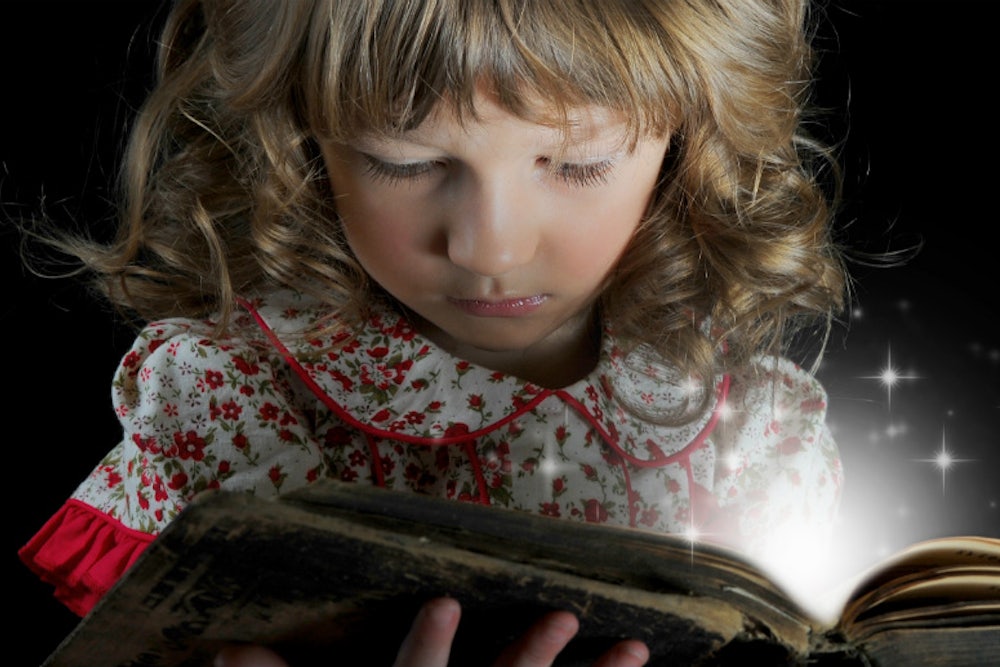My youngest son adores his Ladybird Well Loved Tales collection. It’s the same collection I had as a child, including all the old classics: The Princess and the Pea, Rumpelstiltskin, Beauty and the Beast, The Princess and the Frog. Over the last year they have become an essential part of the bedtime routine.
While the books themselves are not labelled as “for boys” or “for girls,” some of the stories have recently crept into gendered anthologies. Cinderella and Sleeping Beauty feature in Fairy Tales for Girls, while Jack and the Beanstalk and The Three Little Pigs appear in Favourite Stories for Boys. While some parents might breathe a sigh of relief at the publishers having avoided the apocalyptic consequences of placing the word “fairy” anywhere near the word “boys,” a growing number of us have found such an approach limiting and sexist. Hence for us it’s good news that, thanks to pressure from the campaign group Let Books Be Books, Ladybird have confirmed that they will no longer be publishing any more specific ‘girl’ or ‘boy’ titles.
I find this news pleasing not just as a parent, but as someone who has worked in the educational publishing industry for several years. While I don’t believe we should gender books—they are for everyone—I’m very conscious of some of the reasons why publishers feel the need to do so, particularly when it comes to encouraging children to read. In recent years panic over male underachievement in literacy has led to the growth of specific reading schemes for boys. While these reinforce some stereotypes regarding aggression, the one they seek to overcome—“boys don’t read”—is certainly an important one to challenge. Similarly, while the stereotype of girls liking everything to be pink and Hello Kitty branded isn’t exactly gratifying, if it’s used to get them studying science, then maybe it’s okay?
Personally I have mixed feelings. Publishers don’t work in a vacuum. If the prospect of carrying a pink GCSE textbook is enough to dissuade a boy from taking GCSE French, then I’d rather the cover wasn’t pink. But once we start tailoring our books to meet and reinforce the stereotypes children have already absorbed, the effect can be counter-productive. We remind children that they are doing an activity at which they are traditionally expected to fail (hence putting them at risk of stereotype threat). If a girl’s maths books remind her that she is not a person but a girl doing math, the voice saying “but girls can’t do math, can they?” is never really silenced.
One might argue that since the Ladybird collections are for homes and libraries, the issue is less contentious than for schools. If a parent wants to buy a child a specific “boy” book, they will carry on choosing the one with the blue cover. Even so, the removal of the specific “for boys” directive matters. Children notice these things. My eldest child doesn’t mind what color his books are but he takes written rules very seriously. He once ran out of a train station screaming, having spotted a fuse box bearing the label DANGER: RISK OF DEATH; I don’t think he’d risk reading anything that seemed, in his eyes, to explicitly warn him off. We might think our children aren’t interested in learning rules, but that’s not true; some children might like breaking them, but they absorb them all and what’s more, they don’t forget. Hence the removal of pointless “keep out signs” based on gender prejudice is a victory, albeit an incomplete one. We need to look not just at the cover, but at what is inside.
Part of me is delighted that my youngest likes fairy stories, even the ones which ended up in Fairy Tales for Girls. Nevertheless, I have to admit that the Well Loved Tales aren’t quite as I remembered them. The words are the same but reading them as an adult, I’m suddenly aware of the very clear messages about gender embedded within them. I didn’t notice this as a child. I thought it was all “happy ever after.” It turns out it’s not. Being a princess isn’t all it’s cracked up to be.
The Princess and the Pea is one long metaphor for testing the virginity of royal brides. In Rumpelstiltskin, the miller’s daughter ends up “happily” married to a man who has threatened to kill her more than once. The Beast emotionally blackmails Beauty into declaring her love for him, lest her rampant beastphobia should lead to his suicide. In The Princess and the Frog, the princess learns that once you promise to take someone into your bed, you can’t back out of it, however much it disgusts you. Basically my childhood favorites turned out to be Fifty Shades of Grey set in a gingerbread house.
We can change the book’s cover—we can say “anyone can have this book”—but if the content of the book hasn’t changed, it still has the power to limit our children’s aspirations. The subservient princess, the abusive king, the entitled beast—these are not the only roles available. Instead of changing where we place ourselves in relation to a narrative, we need to go one step further and challenge the narrative itself.
I’m not for one moment saying we should ban Well Loved Tales (not least because 1. the Spectator would love it and 2. my five-year-old would never speak to me again). Even so, what this does show is that when it comes to gender, it’s not enough to switch the labels around. That’s only the start. We also need to look at what it is we’re labelling. Anyone can be a princess, anyone can be a beast. But is the princess/beast—or masculinity/femininity, abuser/abused—dynamic what we want? Isn’t it time to write new stories in which everyone gets to thrive?
This piece was originally published at the New Statesman.
